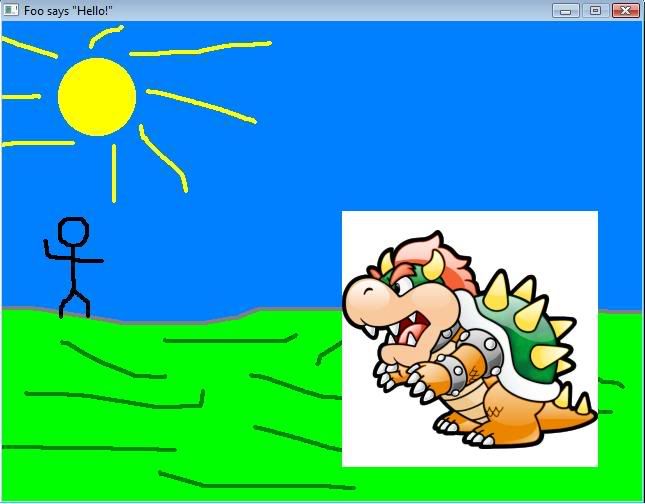
for some reason lazy foo's color coding works on his png but no others lol
at least not for me...
I thought I under stood that the:
if( optimizedImage != NULL )
{
//Map the color key
Uint32 colorkey = SDL_MapRGB( optimizedImage->format, 0, 0xFF, 0xFF );
//Set all pixels of color R 0, G 0xFF, B 0xFF to be transparent
SDL_SetColorKey( optimizedImage, SDL_SRCCOLORKEY, colorkey );
}
}
part of the loadimage method got the color of the background of the image and then set that color to 100% alpha...obviously im doing something wrong lol
could anyone point out my mistake?
btw for ref, heres the entire lazy foo code with mine implemented, just the bowser calls.
#include "SDL.h"
#include "SDL_image.h"
#include <string>
//Screen attributes
const int SCREEN_WIDTH = 640;
const int SCREEN_HEIGHT = 480;
const int SCREEN_BPP = 32;
//The surfaces
SDL_Surface *background = NULL;
SDL_Surface *foo = NULL;
SDL_Surface *bowser = NULL;
SDL_Surface *screen = NULL;
//The event structure
SDL_Event event;
SDL_Surface *load_image( std::string filename )
{
//The image that's loaded
SDL_Surface* loadedImage = NULL;
//The optimized image that will be used
SDL_Surface* optimizedImage = NULL;
//Load the image
loadedImage = IMG_Load( filename.c_str() );
//If the image loaded
if( loadedImage != NULL )
{
//Create an optimized image
optimizedImage = SDL_DisplayFormat( loadedImage );
//Free the old image
SDL_FreeSurface( loadedImage );
//If the image was optimized just fine
if( optimizedImage != NULL )
{
//Map the color key
Uint32 colorkey = SDL_MapRGB( optimizedImage->format, 0, 0xFF, 0xFF );
//Set all pixels of color R 0, G 0xFF, B 0xFF to be transparent
SDL_SetColorKey( optimizedImage, SDL_SRCCOLORKEY, colorkey );
}
}
//Return the optimized image
return optimizedImage;
}
void apply_surface( int x, int y, SDL_Surface* source, SDL_Surface* destination )
{
//Temporary rectangle to hold the offsets
SDL_Rect offset;
//Get the offsets
offset.x = x;
offset.y = y;
//Blit the surface
SDL_BlitSurface( source, NULL, destination, &offset );
}
bool init()
{
//Initialize all SDL subsystems
if( SDL_Init( SDL_INIT_EVERYTHING ) == -1 )
{
return 1;
}
//Set up the screen
screen = SDL_SetVideoMode( SCREEN_WIDTH, SCREEN_HEIGHT, SCREEN_BPP, SDL_SWSURFACE );
//If there was an error in setting up the screen
if( screen == NULL )
{
return 1;
}
//Set the window caption
SDL_WM_SetCaption( "Foo says \"Hello!\"", NULL );
//If everything initialized fine
return true;
}
bool load_files()
{
//Load the background image
background = load_image( "background.png" );
//If the background didn't load
if( background == NULL )
{
return false;
}
//Load the stick figure
foo = load_image( "foo.png" );
bowser = load_image( "bowser.png" );
//If the stick figure didn't load
if( foo == NULL||bowser == NULL )
{
return false;
}
return true;
}
void clean_up()
{
//Free the surfaces
SDL_FreeSurface( background );
SDL_FreeSurface( foo );
SDL_FreeSurface( bowser );
//Quit SDL
SDL_Quit();
}
int main( int argc, char* args[] )
{
//Quit flag
bool quit = false;
//Initialize
if( init() == false )
{
return 1;
}
//Load the files
if( load_files() == false )
{
return 1;
}
//Apply the surfaces to the screen
apply_surface( 0, 0, background, screen );
apply_surface( 40, 190, foo, screen );
apply_surface( 340, 190, bowser, screen );
//Update the screen
if( SDL_Flip( screen ) == -1 )
{
return 1;
}
//While the user hasn't quit
while( quit == false )
{
//While there's events to handle
while( SDL_PollEvent( &event ) )
{
//If the user has Xed out the window
if( event.type == SDL_QUIT )
{
//Quit the program
quit = true;
}
}
}
//Free the surfaces and quit SDL
clean_up();
return 0;
}
 for some reason lazy foo's color coding works on his png but no others lol
at least not for me...
I thought I under stood that the:
for some reason lazy foo's color coding works on his png but no others lol
at least not for me...
I thought I under stood that the:






